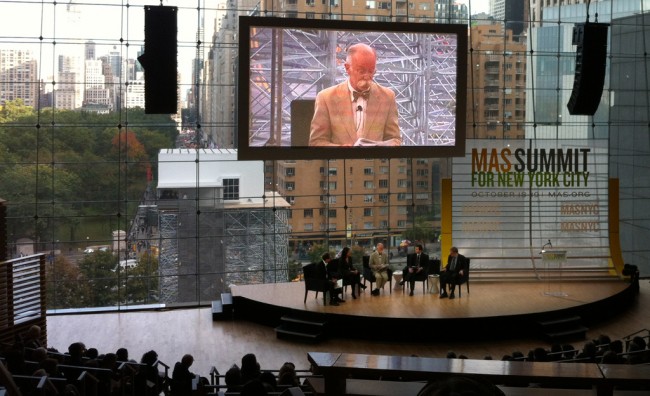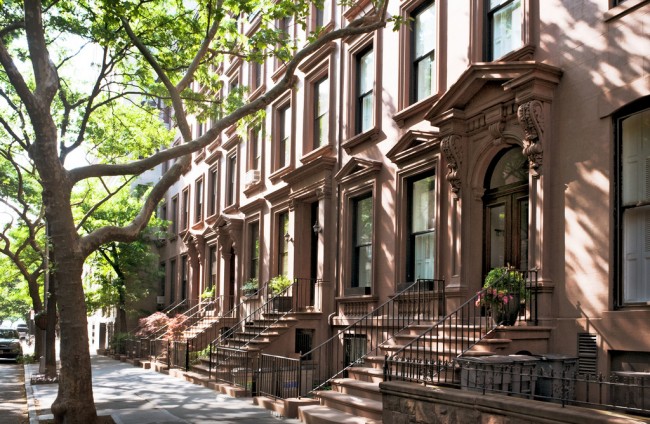
We are celebrating 15 years — and counting — of stories that are deeply researched and deeply felt, that build a historical record of what the city has been.
We are celebrating 15 years — and counting — of stories that are deeply researched and deeply felt, that build a historical record of what the city has been.

Panelists discussing the future of midtown east. From left to right: Charles Bagli, Edith Hsu-Chen, John West (pictured on screen), Michael Chappell, and Tony Hiss
GRAND CENTRAL TERMINAL: THE NEXT 100
Last week, the Municipal Art Society (MAS) hosted its third annual Summit for New York City, a convening of thought leaders from urban planning, historic preservation, design, and city government. With panels, keynotes, and short talks entitled “The Future of Preservation,” “The Future of Urban Mobility,” “The Future of Midtown East,” and no fewer than three talks called “The Future of New York,” the two-day conference had a clear focus: identifying and debating forward-facing policy priorities that balance the city’s economic competitiveness with its “livability,” the core principle of MAS’s advocacy and preservation efforts.
At the event, MAS released the results of “Grand Central Terminal: The Next 100.” For this design study, three renowned firms — Foster and Partners, WXY Architecture + Urban Design, and Skidmore, Owings & Merrill — prepared bold proposals to knit the beloved station into an urban fabric that is poised to change considerably under Bloomberg administration plans to rezone New York’s central business district (the 70 blocks surrounding Grand Central) such that the supply of office real estate remains on par with what London or Tokyo have to offer.
SOM’s scheme stretches the idea of public space literally to new heights. Placing two new skyscrapers on either side of Grand Central, a large “pedestrian” circular path would hang between the towers. The proposal advances the concept of Privately Funded (as opposed to owned) Public Spaces, or PFPS. WXY’s vision also focuses around elevated pedestrian areas (albeit closer to the ground) that would include large swaths of glass flooring looking onto the street below. The linkages WXY proposes extend beyond the station itself, connecting it more palpably to other 42nd Street attractions like Times Square and Bryant Park. Foster + Partners proposed the most straightforward interventions, such as improved pedestrian plazas and better intersections. The focus on exterior public spaces is in keeping with what MAS President Vin Cipolla argues should drive the transformation of east Midtown: “the public experience must be at the center of the conversation — not the size of buildings.” Read more about the proposals on Archinect and in the Wall Street Journal, and listen to the architects describe their visions in the video below:
MAPPING POPS
The Municipal Art Society unveiled another initiative at the summit, a comprehensive online effort to document and discuss New York City’s 525 Privately Owned Public Spaces (POPS). The occupation of Lower Manhattan’s Zuccotti Park sparked widespread discussion about POPS rules and regulations, a topic Douglas Woodward explored in this Urban Omnibus essay. MAS partnered with Advocates for Privately Owned Public Spaces (APOPS) to create the digital database, which allows users to search, comment on, read histories, and view site plans of the POPS, many of which are clustered in the highrise concentrations of Midtown and Lower Manhattan. The bulk of the research took place during a 2000 study spearheaded by Harvard Professor Jerold Kayden, along with the Department of City Planning (DCP) and MAS. The results were published in Privately Owned Public Space: The New York City Experience. While the book is being updated to include previous 12 years , the website is operating as a “beta” version.
$100 MILLION GIFT TO CENTRAL PARK
The Central Park Conservancy received a $100 million donation this week from John Paulson, a billionaire hedge fund manager who lives on the Upper East Side. The gift, according to Mayor Bloomberg, is “the largest made to any park anywhere.” Half of the donation will enter into the Conservancy’s current $144 million endowment; the other half will fund capital improvement projects. While sure to benefit New Yorkers and tourists alike, the gift also enlivens the debate about public versus private park funding. An article in The Washington Post quotes Geoffrey Croft, president of NYC Park Advocates, on the issue: “There are thousands of other park properties in New York City that desperately need funding… This gift is a reminder of the enormous disparities that exist between the haves and the have-nots.” In its coverage of the gift, The New York Times sums up recent large donations to parks in wealthy neighborhoods, including $35 million to the High Line from the Diller-von Furstenberg Family Foundation and $40 million to Brooklyn Bridge Park by Joshua Rechnitz.
A PAIR OF STREET REPORTS: DESIGN & MEASURE
This past week, The National Association of City Transportation Officials (NACTO) held a conference at NYU entitled Designing Cities, at which it released an overview of its forthcoming Urban Street Design Guide. To coincide with that event, the New York City Department of Transportation (NYCDOT) released Measuring the City, a report that recounts recent street livability initiatives and the metrics used to quantify their effectiveness. NYCDOT Commissioner Janette Sadik-Khan currently serves as the president of NACTO and, in her foreword to the guide, she emphasizes its basis in “on-the-ground, built projects and great streets,” with precedents and examples ranging from temporary actions, like makeshift pedestrian plazas, and long-term planning for multimodal throughways. Measuring the City breaks down agency statistics of major improvement areas, such as traffic speeds, economic improvements, crashes and injuries, and environmental impacts. Striking factoids abound: a 26% decrease in injuries resulting from crashes in Union Square thanks to improved intersections; a 172% retail sales increase for Brooklyn’s Pearl Street businesses by revitalizing underused parking areas; and a 177% increase in cyclists along 1st and 2nd Avenue’s dedicated bike lanes.
A DIFFERENT SHADE OF BROWNSTONE
Handsome brownstones with tall stoops along tree-lined streets are an iconic part of New York City’s built environment and an intimate part of the lives of New Yorkers. Alas, we have reached what historic preservationists are calling “the end of an era,” according to The New York Times. Unbeknownst to most, the brown sandstone used in the original façades of brownstones hailed from the same source, the Portland Brownstone Quarries in Portland, CT, which closed earlier this year. Come November, the quarries’ last bit of stock will run out. Some stone fabricators are scrambling to hoard it away, since soon it will no longer be possible to find a perfect match for needed restorations or renovations. But not all New Yorkers are heartbroken. “It’s like New York City is covered in cold chocolate,” said Timothy Lynch of the Department of Buildings, who also noted the material’s propensity to flake and chip. Love it or hate it, the treasured sandstone will slowly become a thing of the past.

Italianate brownstone #2 (c. 1899), Remsen Street, Brooklyn Heights, New York | Photo by Flickr user lumierefl
EVENTS and TO DOs
DESIGNERS & BOOKS FAIR
This weekend, Designers & Books will host New York City’s first-ever book fair focused on architecture and design book publishing. Designers of all disciplines, from Donna Karan to Michael Sorkin to Massimo Vignelli, will discuss their work and the books that have inspired them. In addition to opportunities for informal conversations and book signings with many of the speakers, an exhibition hall will feature the latest and greatest design book titles (and even some backlist ones) alongside demonstrations from rare book dealers, bookbinders and calligraphers. Ticket costs vary by event and can be purchased online or at the door.
MANIFEST CALL FOR SUBMISSIONS
Manifest is a new “annual independent print journal on American architecture and urbanism,” edited by Anthony Acciavatti, Justin Fowler, and Dan Handel. The project seeks to present a “critical conversation about the state of American architecture, its cities, and its hinterland, tackling head-on what others have abandoned” and is currently seeking submissions for its inaugural issue, entitled “Looking Inward.” Abstracts and proposals are due on December 14th.
The Roundup keeps you up to date with topics we’ve featured and other things we think are worth knowing about.
The views expressed here are those of the authors only and do not reflect the position of The Architectural League of New York.